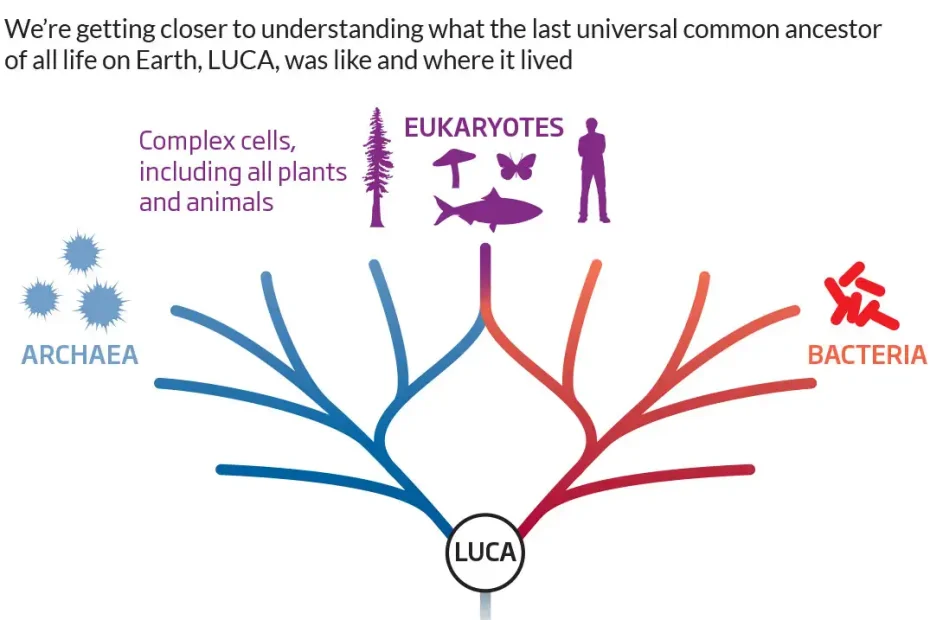When we look at the dazzling variety of life on Earth—trees, fungi, birds, bacteria, and even ourselves—it’s hard to imagine that all of it traces back to a single starting point. And yet, biologists are convinced that every living thing today shares a common ancestor, a kind of “first parent” of life that lived billions of years ago. Recently, scientists have been uncovering new clues about what this ancestor might have been like. Let’s explore these discoveries in a way that makes sense without needing a biology degree.
What Do We Mean by “Common Ancestor”?
Think about your family tree. You, your cousins, and your siblings all share common ancestors—your grandparents. Go back far enough, and eventually, every human alive shares ancestors. The idea works on a much bigger scale, too. All animals share a common ancestor if you go back millions of years. Push the timeline further, and eventually, all living things—plants, bacteria, fungi, animals—connect to one universal ancestor.
Scientists call this ancestor LUCA, which stands for the Last Universal Common Ancestor. LUCA wasn’t the first life form on Earth, but it was the organism from which every modern life form descended.
When and Where Did LUCA Live?
The Earth formed about 4.5 billion years ago, and life appeared relatively early—by around 3.8 to 4 billion years ago. LUCA likely lived during this period. But where?
Some evidence points to hydrothermal vents on the ocean floor, where hot, mineral-rich water gushes from beneath Earth’s crust. These vents create unique environments where chemistry and heat could have powered early life. It’s like a natural laboratory that might have nurtured LUCA and its relatives.
Clues Hidden in Our Cells
Here’s where it gets fascinating: every cell in your body still carries traces of LUCA’s biology. How? Because LUCA passed down essential tools that all life still uses today.
- The Genetic Code: Every living thing uses DNA (or its cousin RNA) to store instructions and proteins to carry out work. This universal system must have come from LUCA.
- Molecular Machines: Inside our cells are little protein factories called ribosomes. These factories are almost identical in bacteria, plants, and humans—suggesting LUCA had them too.
- Energy Processing: New studies suggest LUCA might have been able to harness hydrogen gas as an energy source, something we still see in certain microbes today.
It’s like discovering that all modern cars—from sports cars to trucks—still rely on wheels, an engine, and fuel. The blueprint started long ago and has been modified ever since.
What Did LUCA Look Like?
LUCA probably wasn’t very impressive to look at. It wasn’t an animal, or even a plant. It was likely a tiny, single-celled microbe without a nucleus—more like bacteria than anything else.
But don’t underestimate it! LUCA had:
- A cell membrane to protect itself from the environment.
- A genetic system to copy and pass down information.
- Proteins and enzymes to carry out chemical reactions.
It was simple compared to us, but it was advanced enough to become the ancestor of everything alive today.
Why Is It So Hard to Study LUCA?
The tricky part is that LUCA lived billions of years ago, and soft microbes don’t fossilize well. We don’t have a “body” of LUCA to study. Instead, scientists use comparative genomics—comparing DNA sequences across thousands of species. By looking at which genes are universal, they can reconstruct which ones LUCA likely had.
It’s like reverse-engineering the features of the very first phone by comparing all the smartphones we have today.
Why Does This Matter?
Understanding LUCA isn’t just about curiosity—it’s about answering the deepest questions humans can ask:
- How did life begin?
- What makes all life forms related?
- Could life emerge elsewhere in the universe the same way?
If LUCA thrived in hydrothermal vents, maybe life on icy moons like Europa or Enceladus—where similar vents may exist—could follow the same path.
A Shared Heritage
When you eat an apple, pet a dog, or admire a flower, remember: you, the apple tree, the dog, and the flower all share LUCA as a great-great-great (multiply that by billions) grandparent. We are all branches of the same family tree, connected by a tiny ancient microbe that figured out how to survive—and never stopped passing the torch forward.
Life on Earth may be staggeringly diverse, but at its root, it has one origin story. And that makes us all, in a very real sense, distant relatives.
